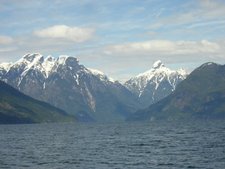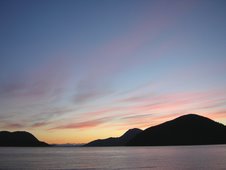 It seems like summer just got here and now fall fast approaches! While we have had a few hot summer days, for the most part this summer has been cool and rainy. I have only had to water my garden twice this year. Of course that means no worries about water from the creek. Usually we have to move our inlet pipe further into the stream to gather water for household use. Not this year. We get our water from a stream just past our property that has a beautiful waterfall. People boating up the inlet often stop to view the waterfall and take pictures. Me too! (see pic). It is one of many, many waterfalls in Jervis Inlet.
It seems like summer just got here and now fall fast approaches! While we have had a few hot summer days, for the most part this summer has been cool and rainy. I have only had to water my garden twice this year. Of course that means no worries about water from the creek. Usually we have to move our inlet pipe further into the stream to gather water for household use. Not this year. We get our water from a stream just past our property that has a beautiful waterfall. People boating up the inlet often stop to view the waterfall and take pictures. Me too! (see pic). It is one of many, many waterfalls in Jervis Inlet.Another famous place for waterfalls is Princess Louisa Inlet at the northern end of Jervis. The following is a story I wrote about a trip to Princess Louisa.
Our group left Egmont with the High Tide Tours & Water Taxi shortly after noon. The day was slightly overcast but the water was calm making for an easy trip up Jervis Inlet. After  stopping to watch the seals on Miller Island, we continued making our way up the inlet. Colors of gold, yellow and red fall leaves reflected in the water. Our captain, Mark, pointed out a fish farm on our way to Soda Pop falls. The falls drop about 25 feet from the bottom of four pools at a sharp angle into the inlet. The water is deep right up to the rock walls in most of the inlet so our boat was able to nudge itself right up to the falls.
stopping to watch the seals on Miller Island, we continued making our way up the inlet. Colors of gold, yellow and red fall leaves reflected in the water. Our captain, Mark, pointed out a fish farm on our way to Soda Pop falls. The falls drop about 25 feet from the bottom of four pools at a sharp angle into the inlet. The water is deep right up to the rock walls in most of the inlet so our boat was able to nudge itself right up to the falls.
As we continued up the inlet, our guide pointed out the remaining dead trees from a large forest fire in 1949. They still stand among the now regrown cedar and fir trees. As we cruised past walls of striated dark and light granite we noticed a white area at the tide’s edge. This is known as the “dead zone” where nothing grows because it is too acidic.
As we turned up Princess Royal Reach we stopped to view some Native painted pictures on the rock wall. Mark pointed out that experts have dated these paintings between 300-700 years old. The red colors are still very vivid.
on the rock wall. Mark pointed out that experts have dated these paintings between 300-700 years old. The red colors are still very vivid.
Our next stop was at the Pargon Logging Camp in Deserted Bay. The water taxi was delivering a rotor head for their helicopter along with an inspection engineer, Dave, from Columbia Helicopters of Oregon. The company leases helicopters and there were two of their Chinook helicopters at the camp. Dave explained that Chinook means “big wind” and as we stood on the dock watching the helicopter rev up we understood why they were given that name. The force of the wind churned up by the blades almost knocked us over!
After leaving the camp we continued up to the entrance of Princess Louisa Inlet. At the entrance to the inlet is the Christian youth camp, Malibu. The colorful totem poles placed among the camp buildings seemed to watch us as we passed through the narrow rapids into the inlet. The camp was quiet after a summer of attendance of hundreds of teenagers and their counselors. The only activity we saw was the smoke curling from the chimney of the caretaker’s cabin.
among the camp buildings seemed to watch us as we passed through the narrow rapids into the inlet. The camp was quiet after a summer of attendance of hundreds of teenagers and their counselors. The only activity we saw was the smoke curling from the chimney of the caretaker’s cabin.
As we approached the Princess Louisa Park dock, a lovely, brown mink greeted us. He stood on his hind legs and watched us before scampering off to shore. In celebration of the birthday of Mike, a member of our tour group, his wife had brought wine, crackers and antipasto. At the dock, among the famous Chatterbox Falls and the green and gold of the inlet, we raised our glasses in a toast and sang “Happy Birthday”.
 stopping to watch the seals on Miller Island, we continued making our way up the inlet. Colors of gold, yellow and red fall leaves reflected in the water. Our captain, Mark, pointed out a fish farm on our way to Soda Pop falls. The falls drop about 25 feet from the bottom of four pools at a sharp angle into the inlet. The water is deep right up to the rock walls in most of the inlet so our boat was able to nudge itself right up to the falls.
stopping to watch the seals on Miller Island, we continued making our way up the inlet. Colors of gold, yellow and red fall leaves reflected in the water. Our captain, Mark, pointed out a fish farm on our way to Soda Pop falls. The falls drop about 25 feet from the bottom of four pools at a sharp angle into the inlet. The water is deep right up to the rock walls in most of the inlet so our boat was able to nudge itself right up to the falls.As we continued up the inlet, our guide pointed out the remaining dead trees from a large forest fire in 1949. They still stand among the now regrown cedar and fir trees. As we cruised past walls of striated dark and light granite we noticed a white area at the tide’s edge. This is known as the “dead zone” where nothing grows because it is too acidic.
As we turned up Princess Royal Reach we stopped to view some Native painted pictures
 on the rock wall. Mark pointed out that experts have dated these paintings between 300-700 years old. The red colors are still very vivid.
on the rock wall. Mark pointed out that experts have dated these paintings between 300-700 years old. The red colors are still very vivid.Our next stop was at the Pargon Logging Camp in Deserted Bay. The water taxi was delivering a rotor head for their helicopter along with an inspection engineer, Dave, from Columbia Helicopters of Oregon. The company leases helicopters and there were two of their Chinook helicopters at the camp. Dave explained that Chinook means “big wind” and as we stood on the dock watching the helicopter rev up we understood why they were given that name. The force of the wind churned up by the blades almost knocked us over!
After leaving the camp we continued up to the entrance of Princess Louisa Inlet. At the entrance to the inlet is the Christian youth camp, Malibu. The colorful totem poles placed
 among the camp buildings seemed to watch us as we passed through the narrow rapids into the inlet. The camp was quiet after a summer of attendance of hundreds of teenagers and their counselors. The only activity we saw was the smoke curling from the chimney of the caretaker’s cabin.
among the camp buildings seemed to watch us as we passed through the narrow rapids into the inlet. The camp was quiet after a summer of attendance of hundreds of teenagers and their counselors. The only activity we saw was the smoke curling from the chimney of the caretaker’s cabin.As we approached the Princess Louisa Park dock, a lovely, brown mink greeted us. He stood on his hind legs and watched us before scampering off to shore. In celebration of the birthday of Mike, a member of our tour group, his wife had brought wine, crackers and antipasto. At the dock, among the famous Chatterbox Falls and the green and gold of the inlet, we raised our glasses in a toast and sang “Happy Birthday”.

Passing through old growth forest along a well-traveled path, it was a short hike to view the falls up close. A prominent sign warns hikers to stay away from the slippery rocks as 22 hikers have met their death here.
The Princess Louisa Society and The Nature Conservancy of Canada have recently given a gift of approximately 2200 acres surrounding the current marine park to the BC government. This will become an addition to the existing Princess Louisa Marine Park. The Society plans to raise funds to purchase additional lots from Weyerhaeuser to add to the Park. Their mission is to protect and preserve the inlet “just like it is” for the benefit of all.
The sun came out as we were leaving Princess Louisa and we made one more stop below a waterfall area where ice had built up at the water’s edge. The captain nosed the boat right up to the ice and as we looked high overhead, we noticed small chunks of ice falling with the water.
As the sun began to set, we made our way back down Jervis Inlet. Watching the surrounding mountains turn pink and purple in the evening light, we all decided this was a perfect ending to our adventure.
The Princess Louisa Society and The Nature Conservancy of Canada have recently given a gift of approximately 2200 acres surrounding the current marine park to the BC government. This will become an addition to the existing Princess Louisa Marine Park. The Society plans to raise funds to purchase additional lots from Weyerhaeuser to add to the Park. Their mission is to protect and preserve the inlet “just like it is” for the benefit of all.
The sun came out as we were leaving Princess Louisa and we made one more stop below a waterfall area where ice had built up at the water’s edge. The captain nosed the boat right up to the ice and as we looked high overhead, we noticed small chunks of ice falling with the water.

As the sun began to set, we made our way back down Jervis Inlet. Watching the surrounding mountains turn pink and purple in the evening light, we all decided this was a perfect ending to our adventure.








